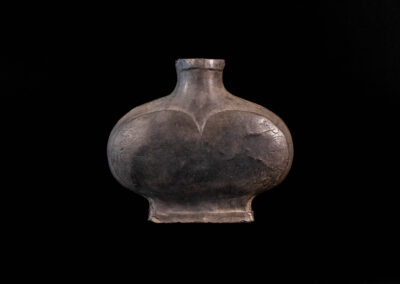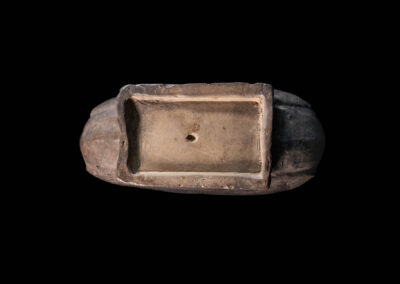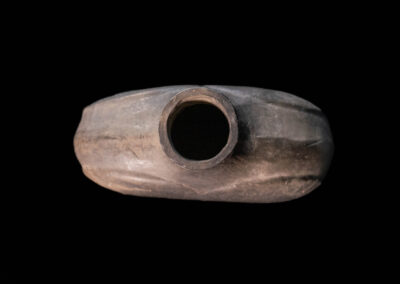Heart-shaped Wine Container
Food & Drink Pottery
Grey-black colored ceramic wine container with an oval cross section. The oval body with a narrow broadside appears in a heart-shape. It is structured into three zones: the irregular formed rectangular standfoot, the heart-shaped body (front and backside) and the short round neck. The hand-formed edges and the model-formed heart create together a frieze. The vessel was used for the cult of the death with the heart as a sign for feelings and life.
Object ID
Han_005
Age
Han Dynasty (206 BC – 220 AD)
Material
Ceramics
Color
grey-brown
Width
19 cm
Depth
8 cm
Height
17 cm
Over Opening
5 cm
Standfoot width
11 cm
Standfoot depth
7 cm
Condition
Good. Standfoot a little chipped off.
Price
on request
Description
Vessels for wine and water in various modifications belonged to the ceramics of the Han period. [1] Here is a typical dark-grey/black lead-glazed container with light cracks. The oval body with a narrow broadside hasd a shaped heart on the front and back. This heart-shape continues on the broad shoulders and on the bottom.
Overall it is structured into three zones: the irregular formed rectangular standfoot, the heart-shaped body (front and backside) and the short round neck. The hand-formed edges on neck and foot create together with the heart sculpt with a model a kind of frieze. The heart was in China considered the seat of the feelings and life. [2]
Those vessels were part of the death cult and found on burial sites. As burial offerings they were – despite the toxic lead-glaze – filled up with wine that should serve the deceased for enjoyment in the next world. Above that also additional items were recreated as grave goods. [3] (HV)
________________________
[1] Goepper, Roger (1968): Kunst und Kunsthandwerk Ostasiens. Ein Handbuch für Sammler und Liebhaer. Keysersche Verlagsbuchhandlung. München. 44
[2] Eberhard, Wolfram (1983): Lexikon chinesischer Symbole. Geheime Sinnbilder in Kunst und Literatur, Leben und Denken der Chinesen. Eugen Diederichs Verlag. Köln. 130
[3] Kieser, Annette (2010): Die chinesische Kunst. Reclam. Stuttgart. 98-99




